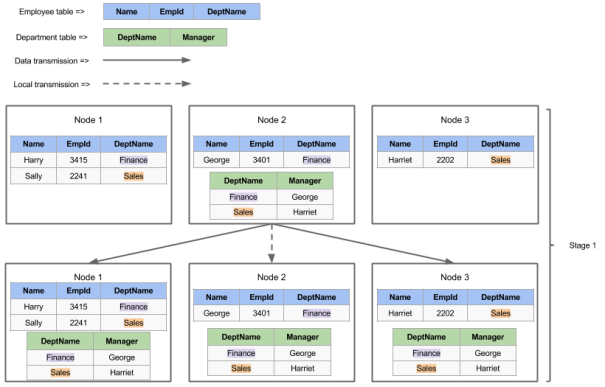Article Source
- Title: Broadcast Join in Tajo
- Authors: Jihoon Son
Broadcast Join in Tajo
Join is one of the most expensive operations in relational world. As a result, many researchers have been studied for efficient join processing.
In distributed systems, there are two well-known join execution algorithms, i.e., repartition joinand broadcast join (There are many other join algorithms including recently introduced Track join, but I won’t handle them here). I’d like to simply present these algorithms before describing broadcast join in Tajo.
Repartition join
Repartition join is executed in two stages. In the first stage, input relations are read and then grouped into multiple partitions according to the value of join key. The result partitions are exchanged between cluster nodes to process the partition of the same value of join key together. This data exchange is called shuffle. In the second stage, every node performs join simultaneously.
Example of Repartition Join (join key = DeptName)
Repartition join works well even for large inputs, and thus is used as the default join algorithm in many distributed systems.
Broadcast Join
The shuffle operation of repartition join might accompany a large overhead especially for small inputs. It includes creating and exchanging partitions as well as scanning data. This overhead is increased in some distributed systems that spill intermediate results between stages onto disks like Hadoop MapReduce or Tajo.
Broadcast join is used to mitigate such overhead when joining small relations. Unlike repartition join, broadcast join is executed in a single stage. At the beginning of the stage, one of input relations (usually smaller one) is simply broadcasted into every node who stores any part of another input. After that, the join is performed in parallel.
Example of Broadcast Join (join key = DeptName)
Please note that the whole relation is replicated to multiple nodes in broadcast join. If a large relation is broadcasted, broadcast join might accompany larger overhead than repartition join. Thus, given a query plan, it is important to decide which part will be executed with broadcast join. This is what I’d like to describe in this post.
Broadcast Join in Tajo
At https://issues.apache.org/jira/browse/TAJO-1553, Tajo’s broadcast join planning have been improved. In this section, I’ll present a brief description of the improvement.
During broadcast join planning, Tajo’s global query optimizer identifies broadcastable partin the query plan according to several simple rules. The following definition will help describing those rules.
Definition: Broadcastable relation. An input relation or an output of a stage is braodastable if its size is smaller than pre-defined threshold.
The default threahold is 5 MB in Tajo. With this definition, we used a simple assumption as follows.
Assumption: If the total size of every input of a stage is smaller than pre-defied threshold, the output of the stage is also sufficiently small and thus broadcastable.
Finally, here are basic rules to decide which part will be executed with broadcast join in Tajo.
- Given a user-defined threshold, the total size of broadcast relations of a stage cannot exceed it.
- A stage containing a join and its child stages can be merged into a
single stage if at least one child stage’s output is broadcastable.
- After merging stages according to the second rule, the result stage may not satisfy the first rule. In this case, enforce repartition join for large relations to satisfy the first rule.
- If every input relation is broadcastable, one of them should not be broadcasted. In this case, the largest one is not broadcasted to minimize the amount of broadcasted data.
The following rules are additionally used when the stage contains outer join.
- Preserved-row relations must not be broadcasted to avoid duplicated inputs.
During outer join execution, tuples of the preserved-row relation are kept in join result regardless of whether they satisfy join condition or not. If the outer join is executed by multiple tasks with broadcasted preserved-row relations, same rows are processed multiple times by different tasks, thereby making the result invalid.
The only case that broadcasting of preserved-row relations is allowed is when the outer join is executed by a single task. This condition cannot be guaranteed by just that every input is sufficiently small (and thus broadcastable) because one of relations can consist of multiple files even though the total size is very small. (Note that tasks are generated for each file when they are smaller than HDFS block in Tajo. If a relation consists of n small files, n tasks will be launched to process each file.)
This complicated condition is difficult to be identified in the current implementation of Tajo’s global query optimizer because the underlying storage layout is concealed from it.
Example of Broadcast Join Planning
The above figure shows an example of broadcast join plan of the query used in the next section. Since there is only a single non-broadcastable relation, the entire query plan will be executed using the broadcast join algorithm.
Simple Performance Evaluation
Here is the simple performance evaluation result.
Query
SELECT
r_name,
case
when l_shipmode is null
then 'N/O' else l_shipmode
end as s1
FROM
region inner join
(
SELECT *
FROM
lineitem left outer join nation
on l_suppkey = n_nationkey
) t
on n_regionkey = r_regionkey
Data
- Input: TPC-H scale factor of 100
- Result: 14484 rows (185.7 KB)
Cluster
- Consisting of one master and 4 workers
- Each worker equips 24 cores, 16 GB memory, and 10 disks
Performance
- Before: 226.915 sec
- After: 49.647 sec
Future Work
As presented above, broadcast join might be limited for outer joins. Especially for full outer joins, broadcast join is prohibited because both inputs are preserved-row relations. This issue will be addressed at https://issues.apache.org/jira/browse/TAJO-1632.


